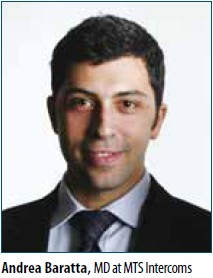Interference between audio and video signals used to cause buzzing; however, it is rarely an issue these days, especially with IP networks, said Derek van der Vorst, CEO of Sound Intelligence. Even though video and audio signals are captured within the same box, video and audio data is sent in separated packets over an IP network. These two signals generally do not interfere with each other. “However, when installing, the wiring location still needs to be put into consideration. For instance, keep wiring away from wireless transmitters, high voltage cables and old-fashioned street lights.”
Interference between audio and video signals used to cause buzzing; however, it is rarely an issue these days, especially with IP networks, said Derek van der Vorst, CEO of Sound Intelligence. Even though video and audio signals are captured within the same box, video and audio data is sent in separated packets over an IP network. These two signals generally do not interfere with each other. “However, when installing, the wiring location still needs to be put into consideration. For instance, keep wiring away from wireless transmitters, high voltage cables and old-fashioned street lights.”
 When doing integration between analog cameras and audio systems, shielded cables can be used to prevent interference. In analog systems, it is very important that the wires used for the transmission have independent references (separated grounds). “Most of the problems are generated by installing high voltage cables too close to low voltage systems,” said Andrea Baratta, MD at MTS Intercoms.
When doing integration between analog cameras and audio systems, shielded cables can be used to prevent interference. In analog systems, it is very important that the wires used for the transmission have independent references (separated grounds). “Most of the problems are generated by installing high voltage cables too close to low voltage systems,” said Andrea Baratta, MD at MTS Intercoms.
“If multiple pick-up points at different physical locations are needed, we suggest using a separate or several audio encoders. The key is certainly to keep wiring of analog signals to a minimum,” added Johannes Rietschel, CEO of Barix. Sound interference also happens if microphones and speakers are deployed too closely. Audio feedback occurs when a sound loop exists between an audio input and an audio output. “In order to avoid audio feedback, microphones and speakers should be situated in such a way that they are acoustically out of the sight as much as possible,” said Elena Ravello, Brand Manager, Fermax. Another way is through specialized echo cancellation codecs, which feature digital filters that reject echoed audio signals within milliseconds.
Video First
Thomas Hagh, VP of Products, Zenitel agreed. “The security industry in general is very video-focused, as guards are helped very much in doing their job by seeing. This is also the case when the guard has a conversation with somebody — a video helps him assess what is happening in the immediate surrounding area, or gets visual clues to state of mind the other party.”
“Requests for audio analytics have started to appear in specifications.” said Hagh. “Specifically there is a need for combined audio and video for door/gate communications and at emergency help points. We expect an increasing demand for our equipment; the main challenge is to bring this new and exciting capability to the attention of the security industry at large.”
 Educating the market is not easy, especially when users are not even aware that integrated solutions exist or are skeptical about their capabilities. “When you speak of video analytics, people understand that a piece of software is scanning through the pixels and trying to group them into objects, ultimately understanding what is going on in the scene,” said Christopher Mitchel, CEO of Audio Analytic. “When you talk about audio analytics, it confuses people because they don't know what it is.
Educating the market is not easy, especially when users are not even aware that integrated solutions exist or are skeptical about their capabilities. “When you speak of video analytics, people understand that a piece of software is scanning through the pixels and trying to group them into objects, ultimately understanding what is going on in the scene,” said Christopher Mitchel, CEO of Audio Analytic. “When you talk about audio analytics, it confuses people because they don't know what it is.
” The general perception of video/audio integration needs to be changed through education. “Customers need to know what audio analytics is capable of and its limits,” van der Vorst said. “When we talk to clients, we make it very clear what can be expected from audio analytics—it provides an additional layer. It is still very difficult to tell the difference between real aggression and a group of drunken people shouting. Both cases it will present as an alarm. Audio analytics can serve as an early warning system, but human verification is still needed to see if follow-up action should be made. As long as the system is integrated well into the VMS and in the working process of the operator, it will only take a few seconds to decide whether follow-up action is needed.”
Human Touch
In addition to the use of open protocols in order to ensure interoperability with other systems, an intuitive interface is crucial as well. “More and more equipment is becoming available to secure buildings and sites in different ways and on different levels, but all this equipment must work together so it is intuitive to use preferably with automation of tasks between different systems,” Hagh said. “End users want equipment which is easy to use. This is clear from some products which are now available in the consumer electronics market and it is also a trend which is visible in the security industry.”
Some intercom manufacturers add a human touch to their products by customizing musician-made bell rings. Customers can even set their preferred bell rings composed by real artists instead of monotonous MIDI ringtones. “In our latest intercom design, we have decided to use our own proprietary ringtones, as a part of the whole design. Bell rings are composed by renowned local musicians. They are free to compose whatever they find most suitable for our product and some alternatives. Later on we choose the one we like most,” Ravello said.
Possible Applications
Not only surveillance camera manufacturers but also intercom players are seeking video/audio integrations in their applications. “Both high- and mid-end customers are starting to ask for video features in our product. Video intercoms provide higher security and comfort to customers as they can have a clear look at their visitor and decide whether to open door or not,” said Ravello. On the other hand, audio detection and analytics can be used to trigger noise cancellation features to enhance sound quality without “pushing” any buttons. “We found this integration especially useful for hands-free devices — such integration allows a more comfortable and clear user experience.”
Surveillance systems can become more effective and proactive by integrating with two-way audio communication. “We see increasing demands for combination of video surveillance plus high quality audio, said Rietschel. “At the ‘output' side, good quality audio allows a very effective ‘call for action', and having high quality audio in addition to video gives much more information for identification of people and of things happening.”
“The wider adoption of video/ audio integration relies not only on market education but also through the firsthand experiences of system integrators and end users gaining familiarity and confidence in what the technology can deliver,” Mitchel said. Increased functionality and reliability will allow such integration to be deployed in a greater range of applications.